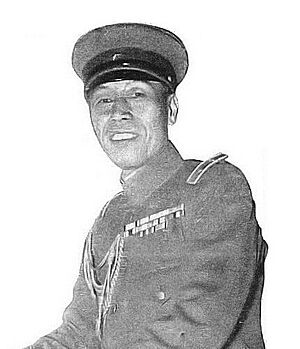Toshizō Nishio facts for kids
Quick facts for kids
Nishio Toshizō
|
|
|---|---|

General Nishio Toshizō
|
|
| Native name |
西尾 寿造
|
| Born | October 31, 1881 Tottori, Japan |
| Died | October 26, 1960 (aged 78) Tokyo, Japan |
| Allegiance | |
| Service/ |
|
| Years of service | 1902–1943 |
| Rank | |
| Unit | 40th Infantry Regiment |
| Commands held |
|
| Battles/wars | Russo-Japanese War
|
| Awards |
|
| Other work | politician |
Toshizō Nishio (born October 31, 1881 – died October 26, 1960) was a Japanese general. Many people thought he was one of the best military leaders and planners in the Imperial Japanese Army. He played a big role during the Second Sino-Japanese War. He led the Japanese Second Army when the war first started, right after an event called the Marco Polo Bridge Incident.
Early Life and Military Career
Nishio was born in Tottori Prefecture, Japan. He studied at the Imperial Japanese Army Academy and finished in 1902. Later, he also went to the Army War College (Japan).
He became a second lieutenant in 1903. He fought in the Russo-Japanese War, including a battle called the Battle of Sandepu. He was promoted to lieutenant in 1905 and became a captain in 1909. He continued to rise through the ranks, becoming a major in 1916 and a lieutenant colonel in 1920.
From 1921 to 1923, Nishio worked with the 10th Regiment. He was promoted to colonel in 1923. After that, he taught at the Army War College until 1925. Then, he became the leader of the 40th Regiment. From 1926 to 1929, he was a chief in the Inspectorate General of Military Training.
In 1929, he became a major general. He was put in charge of the 39th Brigade, which was stationed in Korea. From 1930 to 1932, he worked in the Ministry of War (Japan). He was promoted to lieutenant general in 1933. In 1934, he became the head of a special department in the General Staff.
Serving in China
In 1934, Nishio was made Chief of Staff for the Kwantung Army in Manchukuo. Here, he helped set up the Manchukuo Imperial Army. He also worked to bring peace to the area. In 1936, he became the Vice Chief of the General Staff.
In early 1937, he briefly led the Imperial Guards Division. Soon after, he was sent to China when the Second Sino-Japanese War began.
After the Marco Polo Bridge Incident, Nishio went to North China. He took command of the Japanese Second Army in August 1937. He led operations that took the Japanese army to the Yellow River. He was also involved in the Battle of Xuzhou. His forces crossed the Yellow River and took control of Shandong by April 1938. After his army faced difficulties in the Battle of Taierzhuang, he was replaced. He returned to Tokyo to become the Inspector-General of Military Training.
Nishio was promoted to general in 1939. He went back to China to lead the Japanese Thirteenth Army for a month. Then, in September, he took command of all Japanese forces in China as the Commander in Chief of the China Expeditionary Army. He led battles like the Battle of Zaoyang-Yichang and the First Battle of Changsha. His army also held strong against the Chinese 1939-40 Winter Offensive. They even gained back land in the spring. His forces were attacked again in North China during the Hundred Regiments Offensive. He continued attacks in the Yangtze valley. In March 1941, he was replaced and returned to Japan. He became a member of the Supreme War Council (Japan) until he retired in 1943.
Life After the War
Nishio became the governor of Tokyo from 1944 until the end of World War II. After the war, American authorities arrested him. They investigated him for possible wrongdoing during the war. However, he was never formally charged with any crimes and was later set free.

